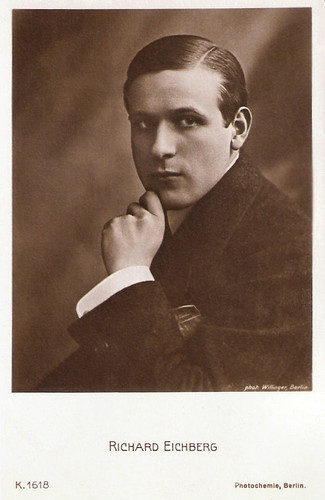
German postcard by Photochemie, Berlin, no. K. 1618. Photo: Willinger, Berlin.

German postcard by Ross Verlag, Berlin, no. 877/2, 1925-1926. Photo: Heinrich Gärtner, Berlin / Richard Eichberg-Film, Berlin. In 1925, Lee Parry starred in four films, produced by Richard Eichberg-Film with cinematography by Heinrich Gärtner: Die Motorbraut/The Motor Bride (Richard Eichberg, 1925), Luxusweibchen/Luxury Wife (Erich Schönfelder, 1925), Die Frau mit dem Etwas/The woman With Something (Erich Schönfelder, 1925), and Der Liebeskäfig/The Love Cage (Richard Eichberg, Erich Schönfelder, 1925).

German postcard by Ross Verlag, no. 1394/1, 1927-1928. Photo: Hameister / Eichberg Film G.m.b.H. Lilian Harvey and Harry Liedtke in Liebe und Trompetenblasen/Love and Trumpets (Richard Eichberg, 1925). Collection: Didier Hanson.
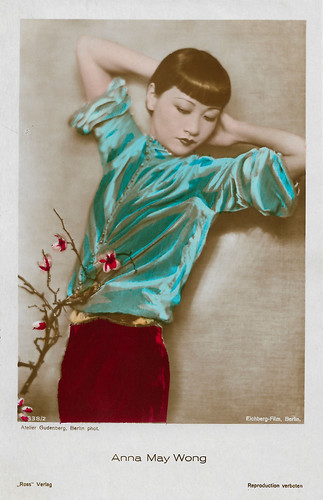
German postcard by Ross Verlag, no. 4338/2, 1929-1930. Photo: Atelier Gudenberg, Berlin / Eichberg-Film, Berlin. Anna May Wong. Collection: Geoffrey Donaldson Institute.

German postcard by Ross Verlag, no. 9451/1, 1935-1936. Photo: Europa / Eichberg Film / Les productions J.N. Ermoliev. Adolf Wohlbrück as Michel in Michel Strogoff (Richard Eichberg, 1936).

German postcard by Ross Verlag, no. A 1239/1, 1937-1938. Photo: Ewald / Eichberg-Film. La Jana in Das indische Grabmal/The Indian Tomb (Richard Eichberg, 1938).
Frivolous and light film comedies
Richard Albert Eichberg was born in 1888 in Berlin. After grammar school, he turned to acting. In 1906, he got his first engagement in Schaffhausen. In 1907 followed an engagement at the Residenz-Theater in Berlin. From 1909 to 1912, he travelled to South America with a touring company.
Around 1907, Eichberg made his first film appearances in ‘Tonbilder’ (early sound shorts). In 1912 and 1913, he acted in Im Banne der Schuld (Hans Oberländer 1912) and several other dramas at Messter's Projection. Subsequently, he worked with Alfred Duskes and Charles Decroix and for the Eiko studio. After the beginning of the First World War, he switched to film direction and production. From 1915 on, he directed and co-produced several short silent films. His debut was the silent melodrama Strohfeuer/Summer Lightning (1915) situated in the Alps. The success of his first films enabled him to found Eichberg-Film as part of Central-Film-Vertriebs-GmbH. He produced mostly crime melodramas. According to Hans Michael Bock at Filmportal, Eichberg offered "well thought-out action cinema based on technical solidity, turbulence, exoticism and sensations."
He directed Ellen Richter in Bacchanal des Todes (1917), of which a beautiful print was found at the Netherlands Filmmuseum in the early 1990s. His productions were the work of well-rehearsed teams, which initially included Ellen Richter as the female star. Then followed Leontine Kühnberg in such films as Die goldene Mumie (1918) and, from 1919, Eichberg's wife Lee Parry (actually Mathilde Benz) became the star of his films. Eichberg directed Parry in her biggest box-office hit, Monna Vanna (1922), one of his more lavish projects. Another success was Die Motorbraut/The Motorist Bride (1924) with Lee Parry and Hans Mierendorff. The film is also notable for Lilian Harvey as a stunt double for Parry during the mountaineering scenes shot in Switzerland. Harvey quickly graduated to become the top star of Richard Eichberg's production company.
In 1921, Eichberg put his company on its own feet with the help of Münchner Lichtspielkunst AG (Emelka Group). At the beginning of the 1920s, he devoted himself increasingly to film comedies and knew how to appeal to the public's taste, which critics both appreciated and criticised. After he separated from Lee Parry, he introduced Lilian Harvey to the screen. First, she appeared in Leidenschaft. Die Liebschaften der Hella von Gilsa/Passion (1925), followed by her breakthrough film Liebe und Trompetenblasen/Love and Trumpets (1925) with Harry Liedtke and the comedies Die Kleine vom Bummel/The Girl on the Road (1925) with Ernst Winar and Prinzessin Trulala/Princess Trulala (1926) with Dina Gralla.
Then Eichberg coupled Harvey with Willy Fritsch for the first time in Die keusche Susanne/Chaste Susanne (1926). The film premiered at the UFA-Palast am Zoo and was a smash hit on its release. Soon, Eichberg lost Harvey and Fritsch to the big Ufa company, where they would become a beloved couple of late silent and early sound cinema in Germany. Eichberg kept his focus on frivolous and light film comedies, which highly pleased audiences but not the critics. Examples are Durchlaucht Radieschen (1927) with Xenia Desni and Werner Fütterer, and Der Fürst von Pappenheim/The Prince of Pappenheim (1927) with Curt Bois and Mona Maris. In the following years, he discovered Anna May Wong, Martha Eggerth and Kitty Jantzen, who became his second wife.
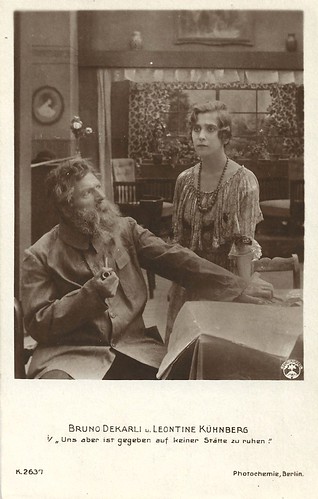
German postcard by Photochemie, Berlin, no. K. 2637. Photo: Eichberg-Film. Bruno Decarli and Leontine Kühnberg in Uns aber ist gegeben auf keiner Stätte zu ruhen (1918). The film title Uns aber ist gegeben auf keiner Stätte zu ruhen (But to us, it is given to rest on no place) is absent on IMDb and Filmportal. From the six films that Richard Eichberg directed with Leontine Kühnberg in 1918, all for his own company Eichberg-Film, a probable option is Im Zeichen der Schuld (Eichberg, 1918), aka Aus dem Leben eines Vorbestraften (From the life of a convicted man). Filmportal lists this as the only film in which Decarli and Kühnberg played together in an Eichberg film. The plot deals with a man (Decarli) who, convicted of forging his boss's name, kills the bank director and assumes his identity. However, the Early German Film Database does list the film Uns aber ist gegeben, auf keiner Stätte zu ruhen as a separate film (1918), directed by Eichberg, and starring Decarli and Kühnberg. So perhaps, this is a separate film after all.
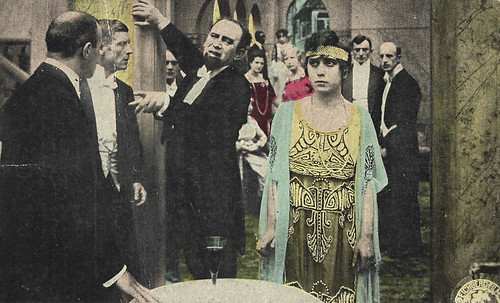
Spanish collector card (cromo) by Chocolat Imperiale, card no. 3 of 6. Photo: Distr. J. Verdaguer, Barcelona / Eichberg-Film. Leontine Kühnberg and Ferdinand Bonn in Die goldene Mumie (Richard Eichberg, 1918).

German collectors card by Ross Verlag in the series Vom Werden deutscher Filmkunst - Der Stumme Film, picture no. 123, group 43. Photo: Eichberg-Film. Lilian Harvey and Hans Junkermann in Die tolle Lola/Fabulous Lola (Richard Eichberg, 1927).

German collectors card by Ross Verlag in the series Vom Werden deutscher Filmkunst - Der Stumme Film, picture no. 199, group 43. Photo: Eichberg-Film. Werner Fuetterer and Hans Junkermann in Durchlaucht Radieschen/Highness Radish (Richard Eichberg, 1927).

German collectors card by Ross Verlag in the series Vom Werden deutscher Filmkunst - Der Stumme Film, picture no. 184, group 43. Photo: Ufa. Dina Gralla in Das Girl von der Revue/The Girl from the Revue (Richard Eichberg, 1928).

Austrian postcard by Iris Verlag, nr. 978. Photo: Eichberg Film/ Verleih E. Welt & Co. Willy Fritsch in Die keusche Susanne/Chaste Susanne (Richard Eichberg, 1926), one of the rare Eichberg productions in which Fritsch played.

German postcard by Ross Verlag, no. 1391/1, 1927-1928. Photo: H. Gärtner / Eichberg-Film. Lucy Doraine in Der Prinz und die Tänzerin/The Prince and the Dancer (Richard Eichberg, 1926).
A lavishly produced jealousy drama
In 1928, Richard Eichberg went to London to produce sound films at the Elstree Studios of British International Pictures (BIP) as one of the first German directors. The most successful of these productions was the crime film Der Greifer/The Copper (1930) with Hans Albers as a Scotland Yard detective. It is the German-language version of the British film Night Birds, by Eichberg but with an English-speaking cast. Der Greifer was a success in Germany, launching Albers as a major star. In 1958, the film was remade with Albers reprising his role.
After the National Socialists came to power in 1933, Eichberg reduced his productivity and worked mainly abroad. He made three Franco-German co-productions at the Paramount studios in Paris-Joinville. These were multiversion films with French and German casts, such as the historical adventure film Michel Strogoff, le courier du tzar/Der Kurier des Zaren (1935-1936), in co-direction with Jacques de Baroncelli. It was an adaptation of the 1876 novel 'Michael Strogoff' by Jules Verne. Adolf Wohlbrück a.k.a. Anton Walbrook starred in the title role in both the French and the German versions.
In 1937 Eichberg shot in India and Woltersdorf the second adaptation of Thea von Harbou’s script of Der Tiger von Eschnapur/The Tiger of Eschnapur and the second part Das Indische Grabmal/The Indian Tomb, starring exotic dancer La Jana, Frits van Dongen a.k.a. Philip Dorn and Kitty Jantzen. Both parts were released in 1937 and were significant box-office triumphs. I.S. Mowis at IMDb: "Thanks to numerous re-runs on television, Eichberg's version is by far the best known. At the least, it is vastly superior to Fritz Lang's kitschy 1958 re-visitation with its doctored 'happy ending' (Lang himself declared this one of his notable failures)." Eichberg also shot the French versions of these two films, now with Alice Field and Max Michel. Back in Germany, state pressure became increasingly intense. Reportedly in spring 1939, Eichberg was given the choice of either selling his Swiss villa property and bringing the foreign currency into the Reich or no longer being allowed to direct in Germany. Eichberg then moved to the USA, where he was employed on various stages in New York, for example in the summer of 1942 in the Broadway production of 'The New Moon' and he was the co-financier of Franz Lehar's 'The Merry Widow' at Carnegie Hall. His later move to Hollywood did not bring any new employment for him.
In 1949, he returned to Germany, where his Indian films were being shown again to great acclaim. He settled in Munich and attempted to build on his earlier successes with the lavishly produced jealousy drama Die Reise nach Marrakesch/The Trip to Marrakech (1949) with Luise Ullrich, Paul Dahlke, Karl Ludwig Diehl and Grethe Weiser. Eichberg led a filming expedition to Morocco for location shooting. The final budget amounted to around one and a half million Deutschmarks. The film premiered in Munich on 21 December 1949, aiming for the lucrative Christmas-time release market. It was received with general hostility from critics. While the film was in the same tradition as Eichberg's earlier films, with their exotic settings, it drew more notice for its underlying lesbian theme, which culminates in one female character shooting another dead. The film was a huge flop and ended Eichberg's directing career.
Eichberg produced one more film, the comedy Skandal in der Botschaft/Scandal at the Embassy (Erik Ode, 1950) starring Viktor de Kowa. He then devoted himself to the business of the production company in Munich. It was managed by his son from his second marriage. Richard Eichberg died in Munich, West Germany, in 1952. His grave is in the old section of the Waldfriedhof cemetery in Munich.

German postcard by Ross Verlag, no. 1589/2, 1927-1928. Photo: Eichberg-Film GmbH. / Ufa. Lilian Harvey acted e.g. in the Eichberg production Die keusche Susanne/Chaste Susanne (Richard Eichberg, 1926).

German postcard by Ross Verlag, no. 1662/1, 1927-1928. Photo: H. Gärtner. Werner Fuetterer in Durchlaucht Radieschen (Richard Eichberg, 1926-1927).
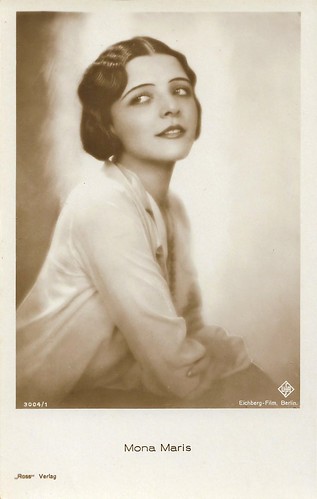
German postcard by Ross Verlag, no. 3004/1, 1927-1928. Photo: Eichberg-Film, Berlin. Ufa. In 1927-1928, Mona Maris acted in several films of Eichberg Film, including Der Fürst von Pappenheim (Richard Eichberg, 1927) distributed by Ufa.
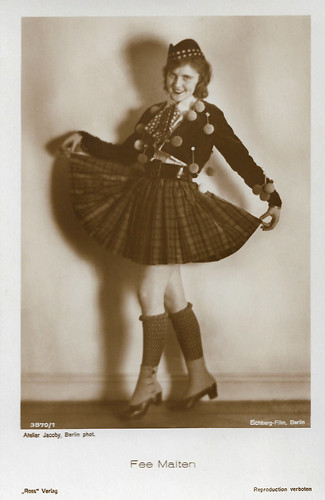
German postcard by Ross Verlag, no. 3870/1, 1928-1929. Photo: Jacobi, Berlin / Eichberg-Film. Fee Malten.

Polish postcard by Polonia, Krakow, no. 1320. Dina Gralla and Harry Halm in Wer wird denn weinen, wenn man auseinandergeht?/No Use Crying If Your Sweetheart Goes Away (Richard Eichberg, 1929).

German postcard by Ross Verlag, no. 5308/1. Photo: H. Gärtner / SF / Eichberg-Film, Berlin. Hans Albers in Der Greifer/The Snatcher (Richard Eichberg, 1930).
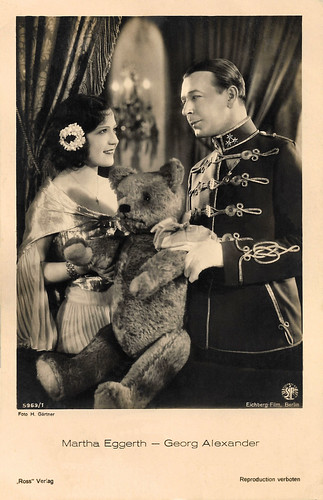
German postcard by Ross Verlag, no. 5969/1, 1930-1931. Photo: H. Gärner / Eichberg-Film / SF. Marta Eggerth and Georg Alexander in Die Bräutigamswitwe/The widow of the groom (Richard Eichberg, 1931).

German postcard by Ross Verlag, no. 7373/1, 1932-1933. Photo: Lindner / Eichberg-Film. Theodor Loos and Trude von Molo in Die unsichtbare Front/The Invisible Front (Richard Eichberg, 1933).
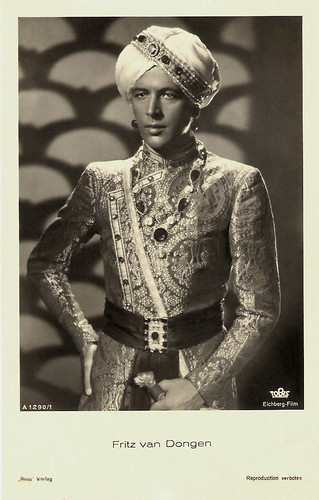
German postcard by Ross Verlag, Berlin, no. A 1290, 1937-1938. Photo: Tobis / Eichberg-Film. Frits van Dongen in Der Tiger von Eschnapur/The Tiger of Eschnapur (Richard Eichberg, 1938).

German card by Starfoto Hasemann, no. 271. Photo: Herzog Filmverleih. La Jana in Der Tiger von Eschnapur/The Tiger of Eschnapur (Richard Eichberg, 1938). The card was made for a re-issue of the film after the death of La Jana.
Sources: Hans-Michael Bock (Filmportal - German), I.S. Mowis (IMDb), Wikipedia (German, Italian and English) and IMDb.
No comments:
Post a Comment